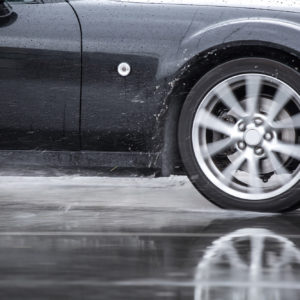Driving on gravel roads can be dangerous due to the lack of traction. Since gravel is loose and gritty, it’s significantly easier for a vehicle to slip and slide while driving. Loose gravel can also get kicked up, damaging components like the exhaust, headlights, and windshield.
Fortunately, there are steps you can take to drive safely on gravel roads to prevent (or at least minimize) the damage your vehicle takes.
Avoid Sharp Turns and Hard Braking
If you find yourself on a gravel road, avoid making sudden turns. If a vehicle suddenly changes course, it loses traction and becomes more likely to skid out of control. Instead, it’s better to keep driving straight and turn slowly to give your vehicle’s tires more grip on the ground.
Similarly, slamming the brakes or forcing a hard stop can make your vehicle slide and skid off course. Brake gently to prevent your tires from losing traction.
Drive Slowly
Maintaining a slow and steady speed will give you more time to react in case something unexpected happens. If your vehicle skids, a road hazard appears, or an auto part gets damaged, you’ll have significantly more time to react and adjust your driving accordingly.
Driving slowly also gives you significantly more control over your vehicle. Slow driving also reduces the amount of dust that’s kicked up from the road, improving visibility.
Engage Four-Wheel Drive
Another way to maintain control over your vehicle when driving over gravel roads is to engage the 4WD system. This allows your vehicle to provide torque to each of the four wheels simultaneously, making it easier to drive over rugged and gritty terrain like gravel.
This way, you’ll be significantly less likely to lose traction and veer off course. Similarly, you’ll have a much easier time recovering in the event that your vehicle skids, slides, or spins.
Bear in mind that 4WD should only be used when necessary. It does more harm than good on dry pavement, creating excessive noise and damaging drive components.
Follow Tracks Left By Other Drivers
To maximize control over your vehicle, drive in the center of the road and try to stay within the tracks left on the gravel road by other vehicles.
Loose gravel is typically found on the shoulders of gravel roads. Gravel that’s already been flattened and pushed further into the earth is more stable, making it safer to drive over.
Just keep an eye out for other drivers who want to overtake you. Pull over for oncoming vehicles and reduce your speed if you have to.
Look Out For Road Hazards
Always look out for potential hazards on the road such as potholes. These can be devastating because they often have sharp, jagged edges and deep drops that can damage your tires and struts.
Rocks on gravel roads are also more likely to fly and damage critical car components so be sure to keep an eye out for them.
Lower Your Tire Pressure
One of the best ways to make driving on gravel roads safer is to adjust the tire pressure, making it lower to increase the size of the contact patch with the ground. Doing so enhances traction, making it easier to control the vehicle while simultaneously reducing the likelihood of dust and stray stones getting kicked up.
But what tire pressure is too low for safe driving? A vehicle’s tire pressure doesn’t just affect its traction. It also affects its fuel economy, handling, and wheel condition. It’s strongly recommended to use tires with an air pressure of 28-30 psi to maximize traction on gravel roads without compromising the integrity of the tires.
Maintain A Safe Distance From Other Drivers
Whether you’re driving on a gravel road or not, it’s a good practice to keep a safe distance from other vehicles. Other drivers are just as likely to skid out of control as you are, which makes them just as likely to become potential road hazards. By keeping a safe distance, you’ll have more time to react in the event that they do lose control.
Similarly, other drivers might kick up dirt, gravel, and stones from the road and send them flying towards you. By staying away, the odds of stray debris smashing into your vehicle and destroying vital auto parts become much smaller.
Any information provided on this Website is for informational purposes only and is not intended to replace consultation with a professional mechanic. The accuracy and timeliness of the information may change from the time of publication.






















